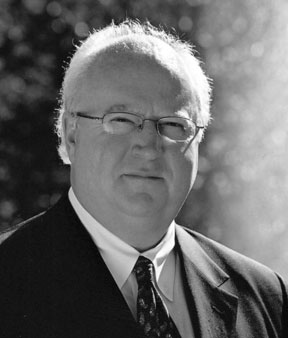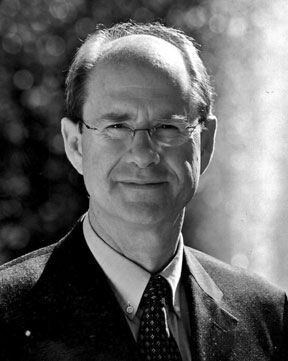Marriages may be made in heaven, but for some couples, the road to the altar is complicated. Premarital counseling may be warranted. But with some divine help, a happy union can be the result.
 |
| We continue to learn from one another, and we both are developing in ways God wants us to be.
President Riley Coulter
Nazarene University College
|
A few years ago, two institutions, both with deep evangelical roots in Canada's prairie provinces, tied the knot. Nazarene University College had been the official liberal arts college of the Church of the Nazarene Canada, which has about 200 congregations nationwide. Until 1995, the school (then called Canadian Nazarene College) was located in Winnipeg, Manitoba.
Alliance University College was affiliated with The Christian & Missionary Alliance in Canada, which has about 430 congregations. As Canadian Bible College / Canadian Theological Seminary, it made its home in Regina, Saskatchewan, until 2003.
The union produced a new school with a new name in a new home town with ties to both churches. Ambrose University College, named after the fourth-century bishop of Milan, occupies a new campus in Calgary, Alberta — in a province supportive of independent and religious higher education. And the school is educating more students than ever, at a lower per-student cost. The institution's leaders feel that in overcoming the challenges to their partnership, they've formed a solid new school with a bright future.
George Durance, who had been president of Alliance University College before becoming the first head of the new postmerger school, emphasizes that the creation of Ambrose was not just about money. "I think if we had just
|

|
|
[The two schools' governing boards] demonstrated a remarkable mix of courage, faith, and restraint.
President George Durance
Alliance University College
|
wanted to save money, we would have been two schools caught in a death embrace," he says. "It was more about gaining strength to move to a higher and broader level of service. This meant that savings were immediately reinvested in new programs and new facilities."
Durance is adamant: "It was about a prayer for greater service."
Tentative beginnings
At the beginning of the four-year conversation that led to the merger, many of the principal players doubted it could even happen. At first, there were hopes for a limited partnership that might result in some cost savings. In the late 1990s, George Durance, the leader of what was then called Canadian Bible College / Canadian Theological Seminary, began an informal discussion with Riley Coulter, president of what was then called Canadian Nazarene College. Both of them stress that talks were based on their mutual desire to create educational opportunities built on a foundation of Christian character formation and expanded service to the church.
At the start of the conversation, "I was fairly certain that merger was not a possibility," says Coulter, who is now chancellor of the merged school. "The mutual invitation was to partner to the degree that it would be advantageous to both schools." They thought of sharing resources in recruitment, enrollment, and student development, but the idea of "sharing" evolved into a more thoroughgoing collaboration in certain functions.
But the word merger was still dynamite. "Merger was a contentious word that was sure to spook and provoke," says Durance. He says he introduced the word integration to avoid the more threatening term. "Only at the end of the process did Dr. Coulter begin using merger, and once he did, it became the accepted language of the day," says Durance. "We trusted his intuition on the timing of its usage. As in any courtship, knowing what to say and when are two different things — and both are critical."
How much to integrate?
Ken Draper, a professor of history in the faculty of arts and science, says that faculty members were most concerned about curricular issues. "Discussions of curricular integration were entirely at the level of faculty," he says, while "integration of administrative and governance functions happened at the administrative and board levels."
Draper was formerly an associate dean of Canadian Bible College and later the senior vice president for academics at the merged institution. He recalls that there were "integrationists" and "separatists" in the faculties of both schools. "The integrationists were looking for as much intersection of the programs and administrations as was possible," he says. "The main attraction of integration and the move to merger was bringing together strengths to build and expand programs."
On the other hand, Draper says that within the same faculties, "the separatists did not really trust the vision of the other school." In his recollection, some faculty at Nazarene University College believed that since the other school was a Bible college, the academic standards were not rigorous enough. In response, the Nazarene faculty resisted any change in academic standards.
But some of the Bible college faculty resented this attitude, Draper says, believing that the Nazarene faculty members were not supportive of a curriculum that focused on preparation for ministry. Some felt that the Nazarene faculty did not fully embrace a "Christian educational model." And there was tension about the economic realities: Canadian Bible College, the allegedly less rigorous school, brought the majority of students and financial resources into the partnership.
Now Draper can see the mutual benefits that both sides may have overlooked at first. Nazarene University College received a new campus and an infusion of financial resources. And Canadian Bible College benefited from the program development and accreditation that Nazarene University College had already achieved. Draper explains that the merger gave both schools access to the other's constituencies, and the new institution is now embracing a new interdenominational identity.
 |
| Click here for full-sized version of the vine time line. |
Essential transparency
Because the province of Alberta has legislation friendly to the accreditation of Christian university colleges, both of the merging schools relocated to Calgary (and changed their names) during the 1990s and 2000s. With so much up in the air, talks about collaboration might have stalled. But Riley Coulter, who was then president of the Nazarene school, reports that the talks progressed as the governing boards of both institutions were kept up to date both informally and formally. George Durance, president of the Alliance institution, says that students "caught the vision and became strong proponents of the proposed merger." The students could easily see the advantages of combined programs and joint activities.
Both schools were strong enough to remain independent, but both sides came to see mutual advantages. There were few overlaps in faculty expertise, since the Nazarene school had greater depth in liberal art disciplines, while the Christian & Missionary Alliance college had a dual focus on preparation for ministry and a holistic preparation for life.
"Our liberal arts platform was our strength, and this caught the attention of the Alliance people," says Coulter, the Nazarene president. "The Alliance strengths were their numbers of students, their theology degrees, and their money." He says that the other school had a stronger donor base. Durance, the president of Canadian Bible College, believes that his school's stakeholders had a vision that was bigger than merely preserving the best of the past. His donors and denominational leaders were "visionary, resilient, and loyal," he says — not to a fading past, but to a hopeful future.
Howard Wilson, the president of the merged institution, says that transparency on both sides was essential.
Hurdles to overcome
But there were challenges. Durance says that at first, the proposed partnership seemed like a loss to some supporters — a violation of the trust that donors had placed in the institution and a "shameful ignoring of the wounds acquired in a prolonged fight for survival."
Of course doctrinal disagreements, which at one time had defined the denominations, couldn't be ignored. But Durance says that most supporters realized that the finer points of doctrinal differences were no longer perceived to have the importance they once had had. Denominational leaders, as "guardians of the received theological traditions," were careful that theological issues were not ignored, and even today, students take courses on polity and history that compare the two traditions. But Howard Wilson says that most students and faculty focus on the commonalities between the Nazarene and Christian & Missionary Alliance traditions. "We are bi-denominational," he says. Wilson himself is a Presbyterian who was executive vice president at Fuller Theological Seminary before he was called to lead Ambrose.
Another hurdle that the two schools faced was inherently practical. To move to Alberta, both had sold their campuses and were occupying leased facilities. Durance says that the sales of both schools' previous campuses had netted them little. "This meant we had to find or build a new campus that could facilitate the shared vision," he says.
Beyond challenges to lessons
 |
| We find older alums from the original institutions now saying, "I am an Ambrose graduate."
President Howard Wilson
Ambrose University College
|
President Howard Wilson says that most hurdles are in the past, and he is now in a position to focus on the advantages of the merger. Some of these were pragmatic, although former Bible college and seminary president Durance says that quantifying them ended up being more complicated than they had thought. "Synergies created efficiencies which saved money — or did they?" he wonders. "In the end, the synergies left us serving more students at a decreased cost per student, but our absolute costs grew because of increased enrollment, the addition of more programs, and an enlarged campus."
But the merger achieved something perhaps even more important than lower per-student costs. "Because the merger was about a vision of what two schools and two denominations could do together, it was a model for Canada," says Durance. "It was an ideal of a new kind of service created by cooperation." He believes that Canadian church and educational leaders will be inspired by the reality that a united institution can do more for students, the two denominations, and the public than the two predecessor schools could have achieved separately.
"This is a story that will likely be told for the next decade and which in turn gives us a higher, positive profile in the denominational community," Durance says. "And the result is an expanded donor base and enlarged enrollment."
After years of negotiating and compromising, what advice do the principal players have for other institutions that might be thinking of merging? Former Nazarene president Coulter says that from the start, the principals focused on those things that each institution shared rather than on the differences. "If you focus on what you have to give up, it takes away all of the possibilities that might occur," he warns.
Coulter says that he and his counterpart began the talks by enunciating common goals and then saying "why not?" rather than "we can't." But he also suggests that starting a conversation with a merger already in view can be problematic. "Take it in steps," he counsels. "See the process as something that is allowed to evolve."
There were "separatists" on the two schools' faculties throughout the talks. But were there other naysayers as the possibility of a merger became real? "Of course," says Coulter. He says that the skeptics mostly came from the church ranks. "There were denominational loyalists in the local churches," he says. "The Church of the Nazarene is smaller, and some people feared it would lose distinctiveness and be swallowed up." On the other hand, some of the Christian & Missionary Alliance members were concerned that a merger with a liberal arts institution would reduce the commitment of the school to support the national and overseas aspirations of the denomination.
Coulter suspects that in spite of some faculty resistance, most faculty, staff, and students supported the partnership, even though many were apprehensive at some level. "Through the trials — and there were many — the faculty remained loyal and persuasive advocates." Of the 33 or so who moved with the Bible college and seminary from Saskatchewan to Alberta, about 31 were still on the faculty five years later. "It's astonishing, really," he says.
"I am an Ambrose graduate"
English professor Tim Heath says that change is always too fast for some, while others wonder why the process is so slow. "Both kinds of people exist among faculty, staff, administrators, and governors," he says, "so I don't think the goal necessarily lies with expediting the merger process so much as it lies with finding the right pace for everyone involved."
Now Ambrose University College is accredited by three bodies: the Association of Theological Schools in the United States and Canada, the Association for Biblical Higher Education, and the Campus Alberta Quality Council. "I have three masters," President Howard Wilson says.
But Wilson believes the payoff has been worth the toil. "We find older alums from the original institutions now saying, ‘I am an Ambrose graduate.'"
 |
| The new campus of Ambrose University College is seven miles (11 kilometers) west of downtown Calgary, Alberta.
(Photo courtesy of Ambrose University College)
|